As part of the Cambridge Assessment Summit of Education 2019, Group Archivist Gillian Cooke led a breakout session looking back at the technology Cambridge Assessment used in the 19th and 20th centuries. Here she explains how the group has continually embraced innovation. Cambridge Assessment has a 160-year legacy but without technology we couldn’t have started!
Oxford and Cambridge universities were the first UK institutions to offer examinations to school leavers near to where they lived – hence the word ‘local’ in our former name University of Cambridge Local Examinations Syndicate (UCLES).
With centres in Birmingham, Brighton, Bristol, Cambridge, Grantham, London, Liverpool and Norwich, we needed efficient transportation and the new railway network was crucial to the enterprise.
Presiding Examiners carried locked cases to centres wearing academic dress, and such was their status that the local mayor escorted many from the station to the exam centre.
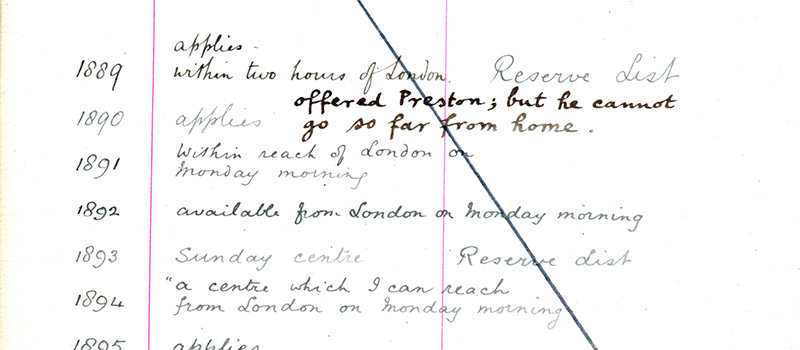 Extract from a Presiding Examiner book
Extract from a Presiding Examiner book
The exams took to the seas in 1864 when candidates began taking Cambridge exams in Trinidad, and by 1900 parcel post regularly carried question papers and scripts between Cambridge and examination centres in the Caribbean Islands, Chile, Hong Kong, India, New Zealand, South Africa, Singapore, Trinidad and the West Indies.
For exams in December, the question papers were dispatched from Cambridge in October with strict instructions for return by February so that the results could be published in the annual class lists.
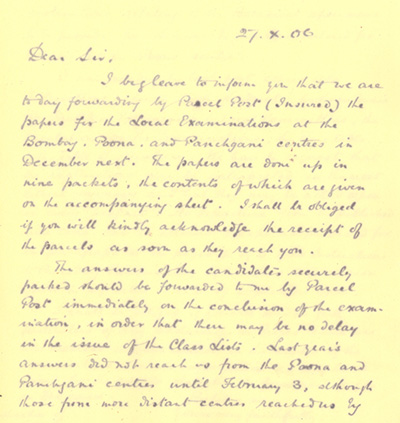 A 1906 letter to a Bombay exam centre requesting the return of answer papers to Cambridge 'immediately on the conclusion of the exam', as some of last year’s scripts were slow in arriving.
A 1906 letter to a Bombay exam centre requesting the return of answer papers to Cambridge 'immediately on the conclusion of the exam', as some of last year’s scripts were slow in arriving.
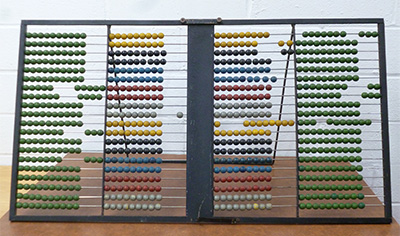
Colours played a key part in the early exam administration process. Different coloured inks were used in coding for the final mark books and coloured beads on the abacus facilitated mark calculations.
Adding machines (mechanical calculators) were introduced in the mid twentieth century, and in a great example of how technological progress defies linear progression, both adding machine and abacus were used throughout the 1960s and 1970s.
In the 1950s the new single subject General Certificate of Education (GCE) fuelled demand for exams as candidates could, at last, gain a complete, recognised qualification in a single subject.
UCLES met this challenge with increased graduate staff, larger premises, modernised clerical arrangements and a Powers Samas punch card machine for dealing with entries, adding and grading marks.
Mindful of the fears that machines would replace staff, management stressed that the changes would enable staff to deal with increasing numbers of candidates more easily than by manual methods.
It is hoped that some of the human energy released by the machines will be available to give more attention than is given at present to the many human problems connected with examinations - UCLES Annual Report, 1957
Indeed, the human element continued to expand. Building alterations in 1961 enabled advancement of our data processing capabilities and the appointment of the first designated officer with ‘experience in the control of a computer’ to strategically plan this development.
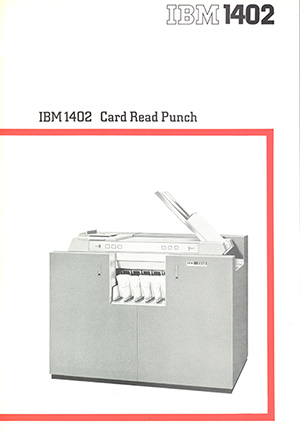 A more sophisticated punch card machine, an IBM 1402, was installed in the 1960s. It automatically checked and coded data before processing results onto blank cards, reading 800 cards and punching 250 cards per minute. The central processing unit, with keyboard, reader and disc drive, were rented for £2,643 per month – the preferred option to keep pace with technological progress.
A more sophisticated punch card machine, an IBM 1402, was installed in the 1960s. It automatically checked and coded data before processing results onto blank cards, reading 800 cards and punching 250 cards per minute. The central processing unit, with keyboard, reader and disc drive, were rented for £2,643 per month – the preferred option to keep pace with technological progress.
Some of our overseas centres directly drove technological progress: in 1971, both Singapore and East Africa asked to receive candidate results on magnetic tape. Paper was still the default, however, and in 1976 we spent a whopping £18,150 (now the equivalent of £124,184) on a photocopier – a monster sized double-sided rank Xerox model – the same year that we paid just £2,144 for a Leyland Maxi car.
Technology then took off in the curriculum. O level Computer Studies was launched in 1978, Technology in 1979 and the following year A level Computer Science became available.
As the 1980s progressed, there was a shift from computer programming to developing skills in computer use in everyday life and work, and a new qualification, Cambridge Information Technology (CIT), was developed.
Initially appealing to school students, within two years CIT’s reach had spread to undergraduates, teachers, prisoners and overseas to countries from Ireland to Thailand.
Meanwhile UK exam entries could now be processed on an IBM 4341, with its maximum memory of 16MB, and in 1987 optical mark reading became a reality. This was the year GCSE was born and as staffing numbers climbed to 800, the numbers of personal computers doubled to 200. A new IGCSE magazine brimmed with expectation that email would be ‘a way of solving communication problems.’
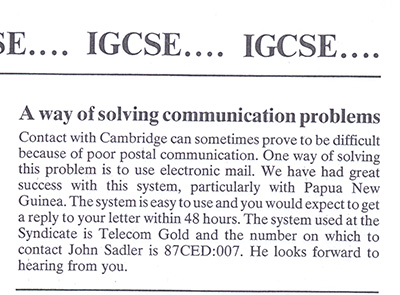 A 1988 IGCSE magazine described email as ‘a way of solving communication problems.’
A 1988 IGCSE magazine described email as ‘a way of solving communication problems.’
The technological march continued and by the time email was fully rolled out, staff were more realistic about its capabilities. Surprisingly it came only a year after the installation of direct dial telephones. More impressively, Cambridge English launched the Computer Adaptive Test, which adapted questions to the learner's ability level. The year was 1994.
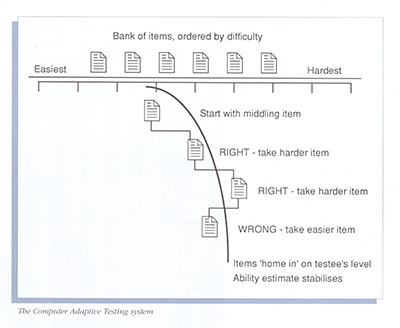 Illustration of the computer adaptive testing system
Illustration of the computer adaptive testing system
The biggest development of the 1990s, however, must surely have been the introduction of the long-awaited Examination Processing System (EPS). At last staff could process and manage information for over five million examinations all on one system. Such was the scale of the development that it was launched in stages from 1994 to 1998.
Cambridge Assessment have always been striving for improvements and here EPS offers an interesting insight: although it took four years to fully implement, our governing body was discussing replacement options in 2003, just five years later.
It’s easy to be amused at the technology of our predecessors and their attitudes to it. It’s more sobering to reflect that these were bold explorations and that without these pioneers, we wouldn’t have springboards from which to jump to the next stage.
Gillian Cooke
Cambridge Assessment Group Archivist